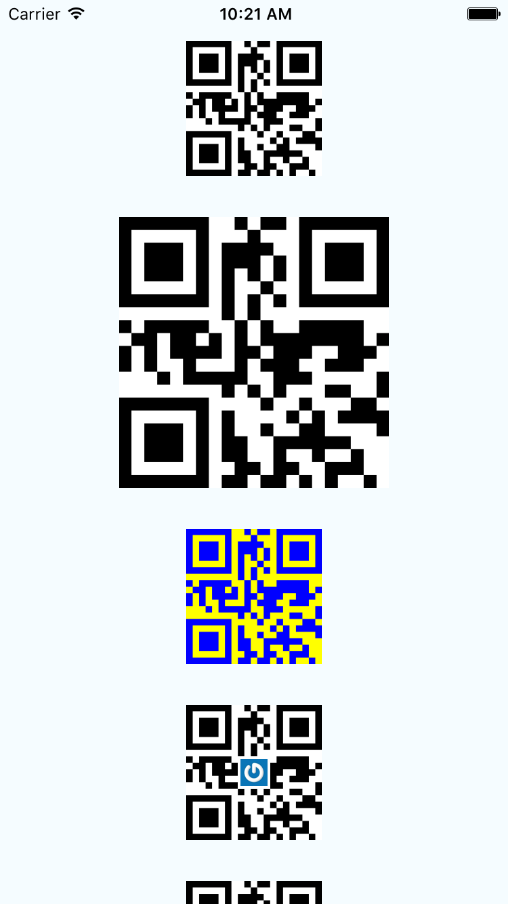react-native-qrcode-svg
A QR Code generator for React Native based on react-native-svg and javascript-qrcode.
Discussion: https://discord.gg/RvFM97v
Features
- Easily render QR code images
- Optionally embed a logotype
| Android | iOS |
| - | - |
|  |
|  |
|
Installation
Install dependency packages
yarn add react-native-svg react-native-qrcode-svg
Or
npm i -S react-native-svg react-native-qrcode-svg
If you are using React Native 0.60.+ go to the folder your-project/ios and run pod install, and you're done.
If not, use one of the following method to link.
Link with react-native link
If you are using React Native <= 0.59.X, link the native project:
react-native link react-native-svg
Examples
import QRCode from 'react-native-qrcode-svg';
// Simple usage, defaults for all but the value
render() {
return (
<QRCode
value="http://awesome.link.qr"
/>
);
};
// 30px logo from base64 string with transparent background
render() {
let base64Logo = 'data:image/png;base64,iVBORw0KGgoAAAANSUhEUgAAAOEAA..';
return (
<QRCode
value="Just some string value"
logo={{uri: base64Logo}}
logoSize={30}
logoBackgroundColor='transparent'
/>
);
};
// 20% (default) sized logo from local file string with white logo backdrop
render() {
let logoFromFile = require('../assets/logo.png');
return (
<QRCode
value="Just some string value"
logo={logoFromFile}
/>
);
};
// get base64 string encode of the qrcode (currently logo is not included)
getDataURL() {
this.svg.toDataURL(this.callback);
}
callback(dataURL) {
console.log(dataURL);
}
render() {
return (
<QRCode
value="Just some string value"
getRef={(c) => (this.svg = c)}
/>
);
}
Props
Name | Default | Description ----------------|------------|-------------- size | 100 | Size of rendered image in pixels value | 'this is a QR code' | String Value of the QR code. Can also accept an array of segments as defined in Manual mode. Ex. [{ data: 'ABCDEFG', mode: 'alphanumeric' }, { data: '0123456', mode: 'numeric' }, { data: [253,254,255], mode: 'byte' }] color | 'black' | Color of the QR code backgroundColor | 'white' | Color of the background enableLinearGradient | false | enables or disables linear gradient linearGradient | ['rgb(255,0,0)','rgb(0,255,255)'] | array of 2 rgb colors used to create the linear gradient gradientDirection| [170,0,0,0] | the direction of the linear gradient logo | null | Image source object. Ex. {uri: 'base64string'} or {require('pathToImage')} logoSize | 20% of size | Size of the imprinted logo. Bigger logo = less error correction in QR code logoBackgroundColor | backgroundColor | The logo gets a filled quadratic background with this color. Use 'transparent' if your logo already has its own backdrop. logoMargin | 2 | logo's distance to its wrapper logoBorderRadius | 0 | the border-radius of logo image (Android is not supported) quietZone | 0 | quiet zone around the qr in pixels (useful when saving image to gallery) getRef | null | Get SVG ref for further usage ecl | 'M' | Error correction level onError(error) | undefined | Callback fired when exception happened during the code generating process
Saving generated code to gallery
Note: Experimental only ( not tested on iOS) , uses getRef() and needs RNFS module
npm install --save react-native-fs
Example for Android:
import { CameraRoll , ToastAndroid } from "react-native"
import RNFS from "react-native-fs"
...
saveQrToDisk() {
this.svg.toDataURL((data) => {
RNFS.writeFile(RNFS.CachesDirectoryPath+"/some-name.png", data, 'base64')
.then((success) => {
return CameraRoll.saveToCameraRoll(RNFS.CachesDirectoryPath+"/some-name.png", 'photo')
})
.then(() => {
this.setState({ busy: false, imageSaved: true })
ToastAndroid.show('Saved to gallery !!', ToastAndroid.SHORT)
})
})
}
Development and testing
This library comes with an Example App. You can find it in the directory ./Example.
Use the app to easily test your changes to react-native-qrcode-svg and when developing new features.
Read more details in the dedicated README.
Dependencies
PeerDependencies
Dependencies
Integrating react-native-qrcode-svg with React Native versions below 0.75
This library works seamlessly with React Native versions 0.75 and above. However, if you're using an older version of React Native (below 0.75), you might need to apply a custom transformation to your project's metro.config.js file to ensure compatibility with the TextEncoder API.
Here's how to configure the transformer for both Expo and React Native projects:
Setting Up the Transformer:
Make sure your project has a metro.config.js file. If not, create one at the root of your project.
Expo Projects:
const { getDefaultConfig } = require("expo/metro-config");
module.exports = (() => {
const config = getDefaultConfig(__dirname);
const { transformer } = config;
config.transformer = {
...transformer,
babelTransformerPath: require.resolve("react-native-qrcode-svg/textEncodingTransformation")
};
return config;
})();
Merge the contents from your project's metro.config.js file with this config.
React Native Projects:
const { getDefaultConfig, mergeConfig } = require("@react-native/metro-config");
const defaultConfig = getDefaultConfig(__dirname);
const config = {
transformer: {
babelTransformerPath: require.resolve("react-native-qrcode-svg/textEncodingTransformation"),
},
};
module.exports = mergeConfig(defaultConfig, config);




